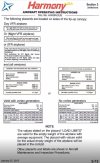Hi.
as power on/off, slow flight, etc outside of the aircraft.
There are a number of models of Evektor, Instruments, Brs....see pic included, make sure that what you have is something that conforms to the speeds and limitations before using any checklists, maneuvers... Ask your CFI to give you a description with proper air speeds, steps...
I included some generic procedures, but make sure your CFI agrees with these steps. One important step for Power on Stall you are, and most LSAs, limited to 4000 RPM.
The most important thing to remember in anything Slow, is Stay coordinated, ball in the center.
Slow flight.
Choose an altitude at least 1,500 AGL.
Scan for traffic.
Reduce power, allow the airspeed to decrease
Maintain altitude.
Maintain coordination
As air speed is decreased into the white arc, add full flaps
Maintain altitude. Additional power is added
Establish 46 – 50 KIAS, an airspeed
Maintain coordination. Maintain heading.
Scan for traffic.
When attitude, airspeed and power have been stabilized, introduce shallow bank turns (15 degrees or less)
Recovery.
Add full power
Retract flaps one notch at a time.
Maintain heading, altitude and coordination.
Allow airspeed to increase to normal cruise.
Reduce power to cruise.
Power On Stall (and Takeoff and Departure Stall)
Choose an altitude at least 2,000 AGL
Use outside references, nose on the horizon.
Clearing turns
Begin on a known heading and altitude
Entry
Gradually retard throttle to idle..
Allow the airspeed to decrease, noting the position of the nose on thehorizon.
Increase pitch attitude to maintain altitude.
Flaps- none.
Allow airspeed to decrease to about 50 KIAS.
Maintain coordination and traffic avoidance.
Apply4,000 RPM power.
Pullback on controls to in-crease back pressure until first sign of stall.
Maintain coordination.
Recognize and recover.
Recovery
Set pitch attitude below the horizon to recover from stall.
Level wings.
Power Off Stall (and Approach to Landing Stall)
Choose an altitude at least 2,000 AGL
Use outside references, nose on the horizon.
Clearing turns
Begin on a known heading and altitude
Entry
Gradually retard throttle to idle.
Allow the airspeed to decrease, noting the position of the nose on the horizon.
Increase pitch attitude to maintain altitude.
As airspeed decreases into white arc, full flaps may be added.
Maintain coordination and traffic avoidance.
Continue to increase back pressure to increase angle of attack until the first sign of stall occurs. (Buffeting)
Recognize the stall and recover.
Recovery
1. Relax back pressure on the control stick to allow nose to come below the horizon.
2. After nose is below the horizon, smoothly add full power.
3. Transition to straight and level flight attitude
4. Maintain coordination.
5. Allow airspeed to increase.
6. Retract flaps prior to accelerating above the white arc.
7. Climb back to initial altitude.
8. Resume normal cruise on original heading
9. On recovery with flaps extended en-sure you do not exceed speed with flaps extended (70 KIAS)

